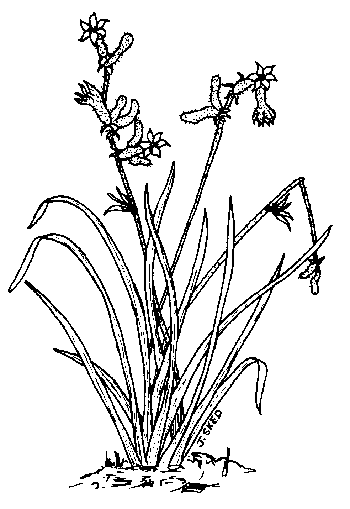
Kangaroo Paw Maintenance
Merv Hodge
Brisbane Society member, Barbara Gunn writes:
"This is my first year to grow kangaroo paw. In February we put two plants of the Outback Ranges Anigozanthos hybrids, 'Tango' and 'Royal Cheer', in a sunny well- drained position. By September there were abundant flowers - six stems of large velvet orange paws on 'Tango' and thirty stems of traditional red and green on 'Royal Cheer'. Should the dead flowers be removed? I saw a television program where leaves and stems were cut back. I missed when this should be done! Horticulture advice would be appreciated."
| |
 |
| |
Anigozanthos flavidus
Illustration: Jan Sked |
To answer the question....
Yes, it is a good idea to cut the plants back after flowering is completed to about 25-50 mm above the crown. Use good clean sharp shears to do the job, but I have heard of people using a brushcutter or rotary mower set at the right height. These are likely to shred and give ragged edges to the leaves and this may lead to some dieback. Remove all off-cuts and burn them or send them to the refuse tip.
The varieties mentioned are amongst the smaller kangaroo paws and these in general are not the best in the ground for this part of the world, but make good potted plants. However, the success of the smaller varieties varies from one variety to another. Some of this will also depend on soil type, air circulation and probably distance from the coast.
I am only referring to south east Queensland and it is likely that further north problems might increase. Anigozanthos 'Royal Cheer', in my opinion, is one of the least likely to be successful in the long term. Anigzanthos 'Bush Tango' has survived at my home for about 3 years, but almost completely dies down during summer to reappear in late autumn or early winter next year. It is certainly a beautiful flower.
I do not water plants at all after about 5 or 6 waterings to get them established. After that they largely or entirely depend on rainfall. However, kangaroo paws are improved by good watering once per week from early winter until flowering has finished. They have to be watered more frequently in pots.
The taller flowering varieties particularly respond to watering by producing bigger and straighter flower spikes. All kangaroo paws in this climate are affected by ink disease (a fungal problem) to some degree. The smaller varieties seem to be more affected than the larger varieties. Even within the smaller varieties, the effect varies from one variety to another to the extent that it appears to be the cause of the death of some.
One grower claims that a product called "Antirot" has been effective in controlling ink disease. It should be noted that it is not registered for controlling ink disease (see Footnote * on this product at the end of this article).
I have some of the larger varieties growing in my garden more than 15 years old. At one stage we grew 500 plants comprising 5 varieties) for cut flowers. Some of the more reliable varieties currently available are 'Big Red', 'Orange Cross' and 'Yellow Gem'. It should be noted that some people have an allergic reaction to the fine hairs on the stems.
I am of the opinion that if you cannot grow these larger varieties successfully, perhaps you are wasting your time with the smaller varieties, except possibly as pot plants. There are new varieties coming onto the market and they may prove to be more reliable. I will look at a range of smaller varieties in a future article. The black kangaroo paw Macropidia fuliginosa is possibly the most difficult and probably should only be tried by the more adventurous.
A. manglesii is the floral emblem of Western Australia and should be mentioned. I treat it as an annual, but I occasionally get 2 years out of it. Plants are usually not available but I grow them from seed available at garden centres.
* * * * * * *
* Footnote: 'Antirot' is a Phosacid systemic fungicide. It is recommended to control Phytophthora Root Rot, Collar Rot and Crown Rot on ornamentals. It warns that some plants may be sensitive to phosphorus acid sprays and should be treated on a small sample first if in doubt.
There is further information on the label on the container. Anyone purchasing this or any other product should fully read the recommendations and precautions before using it. Members may find this product useful for other plants to control the above diseases.
From SGAP Region 'Bulletin', December 2005.
Australian Plants online - 2006
Association of Societies for Growing Australian Plants
|